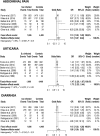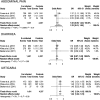Morbidity Associated with Chronic Strongyloides stercoralis Infection: A Systematic Review and Meta-Analysis
- PMID: 30963990
- PMCID: PMC6553888
- DOI: 10.4269/ajtmh.18-0895
Morbidity Associated with Chronic Strongyloides stercoralis Infection: A Systematic Review and Meta-Analysis
Abstract
Strongyloides stercoralis, a worldwide-distributed soil-transmitted helminth, causes chronic infection which may be life threatening. Limitations of diagnostic tests and nonspecificity of symptoms have hampered the estimation of the global morbidity due to strongyloidiasis. This work aimed at assessing S. stercoralis-associated morbidity through a systematic review and meta-analysis of the available literature. MEDLINE, Embase, CENTRAL, LILACS, and trial registries (WHO portal) were searched. The study quality was assessed using the Newcastle-Ottawa scale. Odds ratios (ORs) of the association between symptoms and infection status and frequency of infection-associated symptoms were calculated. Six articles from five countries, including 6,014 individuals, were included in the meta-analysis-three were of low quality, one of high quality, and two of very high quality. Abdominal pain (OR 1.74 [CI 1.07-2.94]), diarrhea (OR 1.66 [CI 1.09-2.55]), and urticaria (OR 1.73 [CI 1.22-2.44]) were associated with infection. In 17 eligible studies, these symptoms were reported by a large proportion of the individuals with strongyloidiasis-abdominal pain by 53.1% individuals, diarrhea by 41.6%, and urticaria by 27.8%. After removing the low-quality studies, urticaria remained the only symptom significantly associated with S. stercoralis infection (OR 1.42 [CI 1.24-1.61]). Limitations of evidence included the low number and quality of studies. Our findings especially highlight the appalling knowledge gap about clinical manifestations of this common yet neglected soil-transmitted helminthiasis. Further studies focusing on morbidity and risk factors for dissemination and mortality due to strongyloidiasis are absolutely needed to quantify the burden of S. stercoralis infection and inform public health policies.
Figures




References
-
- Buonfrate D, Requena-Mendez A, Angheben A, Cinquini M, Cruciani M, Fittipaldo A, Giorli G, Gobbi F, Piubelli C, Bisoffi Z, 2018. Accuracy of molecular biology techniques for the diagnosis of Strongyloides stercoralis infection—a systematic review and meta-analysis. PLoS Negl Trop Dis 12: e0006229. - PMC - PubMed
Publication types
MeSH terms
Substances
Grants and funding
LinkOut - more resources
Full Text Sources
Medical
Miscellaneous

